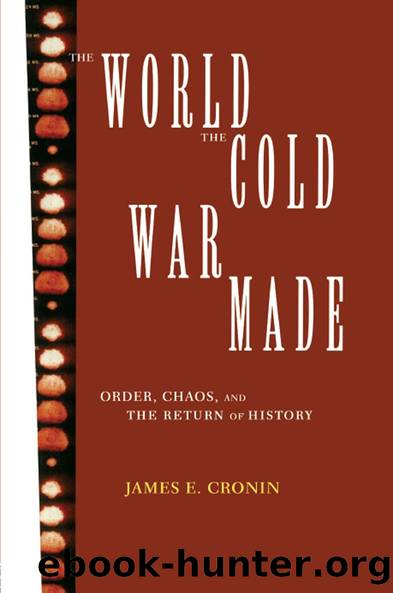The World the Cold War Made by James E. Cronin

Author:James E. Cronin [Cronin, James E.]
Language: eng
Format: epub
ISBN: 9780415908214
Barnesnoble:
Publisher: Taylor & Francis
Published: 1996-07-23T00:00:00+00:00
7 Communismâs Endings
In late spring 1976 George Bush, then director of the Central Intelligence Agency, commissioned a review of the agencyâs estimates of Soviet military strength by a group of outside experts who would come to be known as âTeam B.â Chaired by the âRussophobeâ Richard Pipes, Team B asserted that current CIA reports had been too optimistic about the Soviet Union, underestimating its capabilities and overlooking its aggressive intentions. The reportâs conclusions were leaked in December 1976 in an obvious effort to push the incoming Carter administration away from détente and toward a confrontation with the Soviet Union.1 The manuever hardly seems to have been necessary, though it did contribute marginally to the growing pessimism about U.S.-Soviet relations. The interesting point about the exercise is therefore not its impact, nor its deeply flawed findings, nor what it says about Bush and the post-Watergate gloom of loyal Republicans but, rather, what it reveals about the assumptions surrounding the state of communism in the USSR and about the continued saliency of Cold War ideology.
By the early 1970s, Soviet leaders could boast confidently that the nation had achieved strategic parity with the United States, that its military and political strength had forced the West to recognize the legitimacy and permanence of its domination of Eastern Europe and to acquiesce to the âBrezhnev doctrine,â that its economic record had made these accomplishments possible, and that continued economic growth would sustain these positions of strength and allow further advances. It was indeed âthis shift of the balance of forces in the world arenaâ that had made âpeaceful co-existence and mutually advantageous cooperationâ possible, according to Soviet spokesman Georgii Arbatov. Assumptions about the vitality and stability of the Soviet system were thus at the basis of Soviet foreign policy and of U.S. responses. Arbatov, again, made the connection explicit: âThe possibility of successful talks with the U.S.A. and of positive changes in Soviet-American relations is ensured by the activity of our party, the Soviet state and the entire Soviet people in strengthening the homelandâs economic and defensive might, strengthening the ideological and political unity of our society and consolidating the Socialist Commonwealth.â2 Although U.S. experts debated whether this reality constituted the basis for peace and stability or the promise of confrontation, they agreed fundamentally on the underlying strength of the regime. Years later Pipes would insist that conservatives like him had perceived the mounting crisis of the Soviet system in the early 1980s, and that it was this perception that underpinned the foreign policy initiatives of the Reagan administration.3 But there is no evidence that they or anyone else detected the flaws in the Soviet economy or the fragility of its political system in the 1970s. On the contrary, the left, the right, and and the center shared a view that Soviet achievements were real, that they would persist, and that U.S. policy would have to take Soviet power into account as a structural feature of the system of international relations.
Where policymakers differed was over Soviet intentions.
Download
This site does not store any files on its server. We only index and link to content provided by other sites. Please contact the content providers to delete copyright contents if any and email us, we'll remove relevant links or contents immediately.
Peace as Liberation by Unknown(394)
The American Civil War; A Racial Reckoning by Philip D. Dillard(374)
Warriors - On Living With Courage, Discipline, and Honor by Loren W. Christensen(371)
The Blockade : runners and raiders by Time-Life Books(369)
Softly Softly by Tony Matthews(369)
Bang by [email protected](360)
Nice by Max Gallo(356)
The Voice of War by Guy Walters & Guy Walters(355)
History The Move to Global War by Unknown(340)
Charge! : the interesting bits of military history by Pollard Justin 1968-(337)
Civil War Spies by Robert Grayson(322)
History of Philip's War : Commonly Called the Great Indian War of 1675 and 1676 by Thomas Church; Samuel Gardner Drake(276)
King's Field by Unknown(271)
Memoir of Col. Benjamin Tallmadge by Benjamin Tallmadge(269)
Fighter: The True Story of the Battle of Britain by Deighton Len(268)
The World the Cold War Made by James E. Cronin(267)
1971: Charge of the Gorkhas and Other Stories by Rachna Bisht Rawat(263)
William Pitt and the Great War by J. Holland (John Holland) Rose(243)
Kamikaze Destroyer: USS Hugh W. Hadley (DD 774) by Jeffrey R. Veesenmeyer(236)
